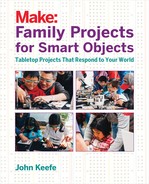Appendix A
Everything You Need
Ingredients
Each project has a small list of parts you’ll need to build the smart object in that chapter. Each chapter also includes a a list of just the parts you need.
If you want to start out with everything you need for the entire book, or just want a picture of what’s ahead, here’s a list of kits that have many of the parts (and often far more), and notes on special parts for different chapters.
All of the parts, and links to the kits, can be found at http://keefe.cc/family-projects.
Kits
These kits have almost all of the ingredients you’ll need for projects in this book.
- Adafruit Experimentation Kit for Arduino ($$)
- Adafruit Starter Pack for Arduino ($$)
- Adafruit Budget Pack for Arduino ($)
- Make: Getting Started with Arduino Kit, Special Edition ($$)
- SparkFun Inventor’s Kit for Arduino ($$$$)
- SparkFun Inventor’s Kit for Arduino – V3.2 ($$$)
Special Parts
For the projects in the last half of the book, starting with “Get Your Arduino Online,” your smart objects will be communicating over the Internet, so you’ll need this wifi board and its mounting headers:
The “Electric Candle” project has a special part—a wind sensor—you won’t find in the kits.
The “Invisible Ruler” project also has a special part that uses sound to detect distance.
Many of the projects suggest an optional power supply, which allows you to untether your Arduino from your computer—and let it run on its own. Arduinos get their power either from the USB port or from the round “barrel” jack next to the Arduino’s USB outlet. If your kit doesn’t come with a separate power supply, you can buy one that fits the barrel jack or a nifty version that uses your Arduino’s USB cable instead.
All of the Parts, Individually
Here’s every ingredient used in the book, in order of appearance:
- 1 Arduino Uno (Revision 3)
- 1 Arduino USB cable
- 1 LED
- 1 breadboard
- 10 jumper wires
- 1 photoresistor
- 2 10k-ohm (10kΩ) static resistors (Stripes: Brown, Black, Orange, Gold)
- 1 static resistor with the highest resistance you have
- 1 photoresistor
- 1 Arduino power supply
- 2 extension jumper wires (male-to-female)
- 1 hollow, translucent toy
- 1 thermistor
- An ice cube
- 1 square of aluminum foil, about the size of a cracker
- 2 pieces of tape
- 1 pressure sensor
- 1 little buzzer
- A small object you cherish :-)
- 1 Modern Device wind sensor
- 1 Parallax Ping sensor
- 1 SparkFun WiFi Shield (ESP8266)
- 1 set of Arduino R3 stackable headers
- 1 set of break-away headers
You can buy the parts individually, by project, or all together, at http://keefe.cc/family-projects.
Tools
A couple of the chapters, including “Get Your Arduino Online,” require a small amount of soldering. You’ll need:
. . . and read one of my favorite online guides to soldering at http://keefe.cc/soldering.
WiFi Service
For the last few projects in the book, we get your smart objects online to fetch and send data via the Internet.
The kind of wifi network we use is typical for home wifi setups—at least in the United States: You pick the network from a list of networks in range and, usually, you enter a password into your device for that network.
As long as you know the network name and the password, you should be good.
More problematic wifi networks are those that pop up a window that looks like a web page and asks for information. This could be a username, a hotel room number, or even just a box you need to check to “accept” the terms for using the network. Such networks are often found in hotels, cafes, and universities, and they won’t work for this book because the Arduino can’t answer the questions or navigate this window.
If you think you’re in that situation, you have a few options:
- Just use the first half of the book. The first eight projects don’t need wifi at all. And you’ll learn a ton.
- Work in a location that has wifi without a pop-up window. Most home and business wifi networks should work.
- See if you can make your cell phone a “hot spot.” Check with the cellular provider you use to find out.
- Buy a “hot spot.” These are little boxes that connect to the Internet like a cell phone and create a little wifi network. They typically cost very little, but can have expensive monthly fees.
- Check with your cable company. Many of them offer subscribers access to their wifi networks around town.
